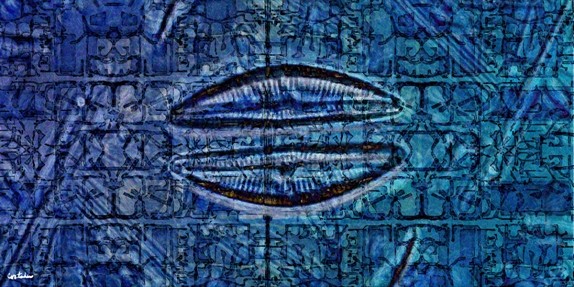FLORIDA IS…DIATOMS
November 8 – November 30, 2018
About | Events | Gallery

Xavier Cortada, “Florida is…Diatoms: Shine,” archival ink on paper (signed, numbered, limited-edition print, edition of 5), 12″ x 12″, 2015.
“FLORIDA IS…DIATOMS”
Diatoms are water-bound, single-celled symmetrical organisms encapsulated in silica. They harness the power of the sun to convert carbon dioxide into oxygen and are responsible for generating one-third of the air we breathe.
Its shell, all that remains from the diatom that lived in the past, is used by scientists today to see what was as they research crucial environmental issues in the century to come. Scientists—and artists—can determine the past salinity of water by examining the glass shells of diatoms preserved in sedimentary core samples.
Each diatom species has a different salinity preference, so changes in the mixture of fresh and sea water (driven by sea level and changes in water management) can be inferred from past diatom remains.
Xavier Cortada collaborated with Florida Coastal Everglades Long-Term Ecological Research (FCE LTER) scientists to better understand the impact of global climate change on our ecosystems. The works in the {in water} exhibition are inspired by their scientific research.
“Diatom,” (2014), is his first work ever depicting a diatom: Using a microscope, Cortada captured the image of a diatom from samples used by Florida International UniversityFCE LTER scientists study the ecology of the Everglades and sea level rise. In the art, Cortada’s diatoms hover over a layer of images (Cortada captured using Google maps) showing the artificial canals and lakes created to develop parcels of developable land where the River of Grass once flowed.
His latest diatom-themed work, “Diatom Court” (2018), is outside the Hibiscus Gallery in the gardens. On Earth Day 2018, it was unveiled as a permanent, site-specific, ceramic installation on the grounds of Pinecrest Gardens.

About the Artist
Xavier Cortada serves as Artist-in-Residence at FIU School of Environment, Arts and Society and the College of Communication, Architecture + The Arts.
Cortada often engages scientists in his art-making: At CERN, Cortada and a particle physicist created a permanent digital-art piece to celebrate the Higgs boson discovery. Cortada has worked with scientists at Hubbard Brook LTER on a water cycle visualization project driven by real-time data collected at a watershed in New Hampshire’s White Mountains.
He has collaborated with a population geneticist to explore our ancestral journeys out of Africa 60,000-years ago, with a molecular biologist to synthesize a DNA strand from a sequence 400 museum visitors randomly generated, and with botanists to develop multi-year participatory eco-art efforts to reforest mangroves, native trees, and wildflowersacross Florida.
The Miami artist has created environmental installations (North Pole and South Pole) and eco-art (Taiwan, Hawaii and Holland) projects, and painted community murals addressing peace (Cyprus and Northern Ireland), child welfare (Bolivia and Panama), AIDS (Switzerland and South Africa) and juvenile justice (Miami and Philadelphia) concerns.
His studio is located at Pinecrest Gardens.